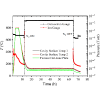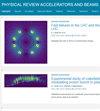Field, frequency, and temperature dependencies of the surface resistance of nitrogen diffused niobium superconducting radio frequency cavities
IF 1.8
3区 物理与天体物理
Q3 PHYSICS, NUCLEAR
Physical Review Accelerators and Beams
Pub Date : 2024-06-12
DOI:10.1103/physrevaccelbeams.27.062001
引用次数: 0
Abstract
We investigate the rf performance of several single-cell superconducting radio-frequency cavities subjected to low temperature heat treatment in nitrogen environment. The cavities were treated at temperature for an extended period of time (24–48 h) either in high vacuum or in a low partial pressure of ultrapure nitrogen. The improvement in with a rise was observed when nitrogen gas was injected at during the cavity cooldown from and held at , without any degradation in accelerating gradient over the baseline performance. The treatment was applied to several elliptical cavities with frequency ranging from 0.75 to 3.0 GHz, showing an improved quality factor as a result of low temperature nitrogen treatments. The rise feature is similar to that achieved by nitrogen alloying Nb cavities at higher temperature, followed by material removal by electropolishing. The surface modification was confirmed by the change in electronic mean free path and tuned with the temperature and duration of heat treatment. The decrease of the temperature-dependent surface resistance with increasing rf field, resulting in a rise, becomes stronger with increasing frequency and decreasing temperature. The data suggest a crossover frequency of above that the rise phenomenon occurs at 2 K. Some of these results can be explained qualitatively with an existing model of intrinsic field-dependence of the surface resistance with both equilibrium and nonequilibrium quasiparticle distribution functions. The change in the slope below 0.95 GHz may result from masking contribution of trapped magnetic flux to the residual surface resistance.

氮扩散铌超导射频空腔表面电阻的场强、频率和温度相关性
我们研究了几种在氮环境中经过低温热处理的单细胞超导射频空腔的射频性能。这些腔体在 120-165 °C 的温度下,在高真空或低分压的超纯氮气中进行了长时间(24-48 小时)的处理。在腔体从 800 ℃冷却到 165 ℃的过程中,氮气的注入温度为 300 ℃,在加速梯度方面与基线性能相比没有任何下降的情况下,观察到了 Q0 的改善和 Q 值的上升。对几个频率在 0.75 至 3.0 GHz 之间的椭圆形空腔进行了处理,结果表明低温氮处理提高了品质因数。Q 值上升的特征类似于在较高温度下对铌腔进行氮合金化处理,然后通过电抛光去除材料。电子平均自由路径的变化证实了表面改性,并随着热处理温度和持续时间的变化而调整。随着射频场的增加,与温度相关的表面电阻下降,导致 Q 值上升,随着频率的增加和温度的降低,Q 值上升的趋势变得更强。数据表明,在 2 K 时,Q 值上升现象发生的交叉频率为 ∼0.95 GHz。其中一些结果可以用现有的平衡和非平衡准粒子分布函数的表面电阻本征场依赖性模型来定性解释。Q 值斜率在 0.95 GHz 以下的变化可能是由于被困磁通对剩余表面电阻的掩蔽作用。
本文章由计算机程序翻译,如有差异,请以英文原文为准。
求助全文
约1分钟内获得全文
求助全文
来源期刊

Physical Review Accelerators and Beams
Physics and Astronomy-Surfaces and Interfaces
CiteScore
3.90
自引率
23.50%
发文量
158
审稿时长
23 weeks
期刊介绍:
Physical Review Special Topics - Accelerators and Beams (PRST-AB) is a peer-reviewed, purely electronic journal, distributed without charge to readers and funded by sponsors from national and international laboratories and other partners. The articles are published by the American Physical Society under the terms of the Creative Commons Attribution 3.0 License.
It covers the full range of accelerator science and technology; subsystem and component technologies; beam dynamics; accelerator applications; and design, operation, and improvement of accelerators used in science and industry. This includes accelerators for high-energy and nuclear physics, synchrotron-radiation production, spallation neutron sources, medical therapy, and intense-beam applications.
 求助内容:
求助内容: 应助结果提醒方式:
应助结果提醒方式:


